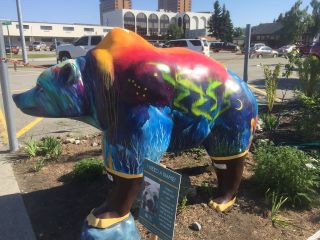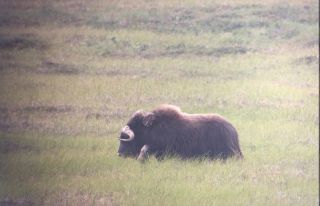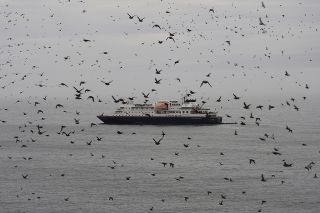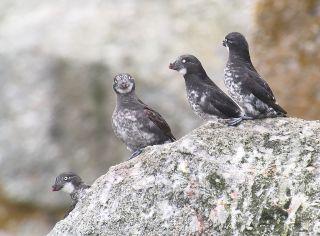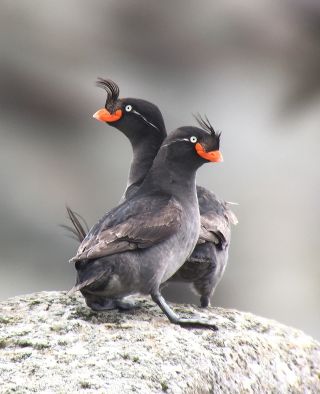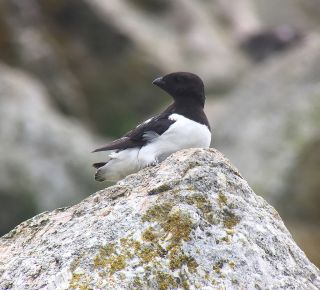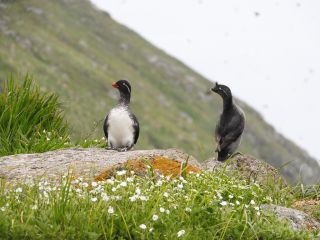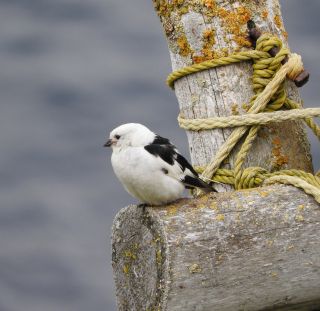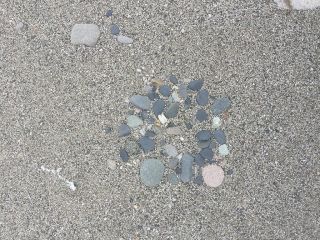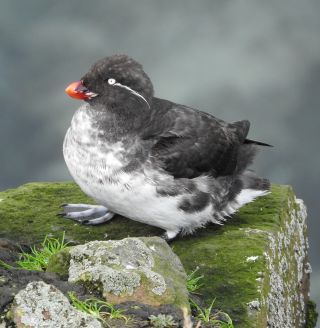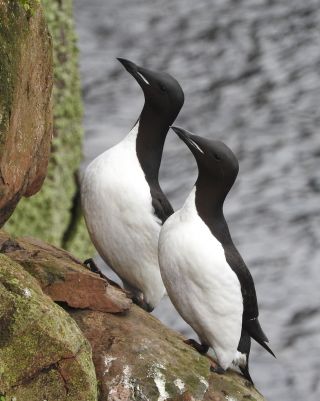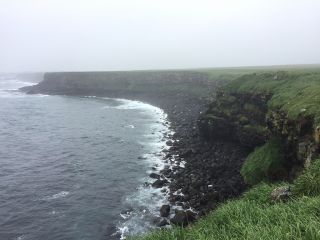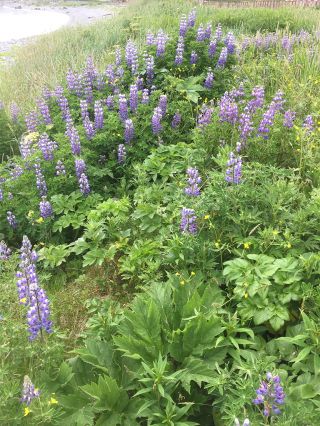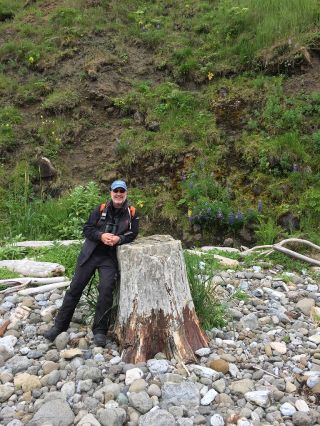Artistic Anchorage Bear in Xtratuf boots © Mark Brazil
Wild Watch Goes to Alaska I
By Mark Brazil | Jul 31, 2017
Alaska! The name alone conjures images of wilderness and “last frontier”, of dramatic landscapes, and fog-shrouded islands. So far though, those adjectives could equally as well describe Hokkaido, the island I call home.
Hokkaido is Japan’s wild frontier, settled relatively late, and with a dramatic landscape dominated by mountain ranges and volcanoes. While Alaska only became part of the union of the USA less than a century ago on 3 January 1959, Hokkaido was incorporated as a prefecture of Japan in 1869 or thereabouts, had been used in a somewhat temporary fashion for several centuries, and like Alaska had been home to indigenous peoples for thousands of years.
Hokkaido to this day is home to bears, eagles and giant owls, and to an indigenous animistic people, the Ainu, who revere a pantheon of nature gods.
There is indeed a kinship between these two regions, though not in scale. Alaska is truly vast; Hokkaido’s grand scale is only in comparison with more southerly, more crowded areas of Japan.
As I sailed up Resurrection Bay towards Seward this summer, at the end of a voyage around the Bering Sea, I remarked to myself that in several directions there were ranks of snow-covered ranges in the Kenai Fjords National Park any one of which would dwarf Hokkaido’s Shiretoko Peninsula NP, despite that finger of land being considered an enormous World Heritage Site here in Japan.
While the kinship between Hokkaido and Alaska does not embrace scale, it can be said to embrace climate as both experience frigid winters and surprisingly warm summers. Summer warmth and cold offshore waters lead to another feature in common, and that is coastal fog. Damp grey landscapes, with low cloud, rain and cloud enshrouded Islands, are as much a typical part of the islands and coasts around southeast Hokkaido as they are of Alaska’s Pribilof and Aleutian Islands. Those summer fogs are why I don’t expect to see much of the landscapes of either the Aleutian Islands or Kuril Islands in spring or summer, and why I avoid flying into Kushiro Airport on summer mornings.
I am fortunate to live in Hokkaido and to have had numerous opportunities to visit Alaska and the Bering Sea since the late 1990s. On this particular occasion my Alaskan voyage began in Nome and ended in Seward, taking in some of the most isolated of the islands in the Bering Sea. Arriving first in Anchorage I found my first evidence of “wildlife” in the form of an artistic street bear, clad in iconic Alaskan brown footwear – Xtratuf boots. Having tried them myself I don’t see their appeal – I am definitely a Muck Boot man myself, but that is another story.
A short flight took me, my colleagues, and various guests from Anchorage to Nome and gave us the opportunity to see the dramatic Alaskan landscape from the air. We had left boreal forests behind in Anchorage, and in Nome we were definitely in tundra territory. There we encountered one of the strangest and most Arctic of all northern mammals, for while polar bears and caribou, both iconic of the Arctic, may resemble their bear and deer relatives, the Musk Ox is completely different from anything else in the Arctic. We found a small herd of these creatures meandering its way across the tundra, grazing as they went. A member of the Bovidae, the Musk Ox is related to the Mountain Goat, and to domestic cattle and sheep, but its several closest relatives are all now extinct. With a long drapery of shaggy fur, a massive skull boss and wide sweeping, pointed horns the Musk Ox appears dramatic yet anachronistic.
Zegrahm Expeditions had chartered the Silver Discoverer and in Nome we boarded our vessel and set sail for an amazing journey around the Bering Sea. Overnight we traded the continental tundra of the Nome area for one of the most remote parts of the USA, Little Diomede Island.
Our goal was to go ashore at the tiny Inupiaq community clinging to the steep flank of Little Diomede, a tiny island situated right in the Bering Strait. Ashore, in the community of Ignaluk, we were intrigued by the compact society and the extraordinary lifestyle of the villagers on this small and remote island, one of the most isolated inhabited communities in the USA. I first visited here in 1998 and little has changed since then other than the arrival of internet, a new school and an increase in the debris of used snowmobiles!
You really can see Russia from here! Little Diomede is situated a mere two nautical miles from its Russian counterpart, Big Diomede, which looms just across the dateline in tomorrow. Even before we landed on Little Diomede we could see the bee-like swarms of auklets in the air over the island, and once ashore the background noise of birds was astonishing. Endless flocks of auklets were swirling round and passing overhead, the sound of their calls and their wings provided a constant rush and roar. Their extraordinary numbers were a marvel, a true ornithological spectacle, making this mixed colony of Least, Crested, and Parakeet auklets one of the greatest natural spectacles on Earth. The sky was filled with birds, the rocks were covered with them and beneath our feet we could hear their calls. With one exception, the experience was all about seabirds, and that exception was the beautifully pied Snow Bunting, a small, hardy songbird that breeds on the island, but which in winter even manages to reach the frozen shores of Hokkaido.
With time to explore the small Inupiaq village of Ignaluk, a subsistence community relying on walrus, seal and bird hunting, and egg gathering, and to visit the talus slopes where thousands of birds were gathering, I was able to soak up this marvel, but despite several visits over the last twenty years I can never get enough. Remembering my very first visit to the island, and how I had randomly placed my tripod and telescope and on looking through it found myself looking at a rarity – a single Little Auk amongst millions of auklets –, I was tempted to do the same. Amazingly my scanning turned up yet another single Little Auk all these years later, it was resting atop a lichen-covered boulder and sent a chill of uncanny déjà vu down my spine. At every turn Least Auklets and Crested Auklets were popping out from beneath the talus. They gathered a while chattering at each other, then somehow, seeming to reach a consensus, they took off in a coordinated swarm joining the aerial throng enshrouding the island.
Returning to our ship by Zodiac along the coast gave a very different perspective on the island, and reminded me of just how precariously the village is built onto the steep slope of the islet, and gave me one final opportunity to marvel at the insect-like swarms of birds circling the island and filling the sky.
South of the Diomede Islands lie St Lawrence Island, Matthew and Hall islands, and eventually the Pribilof Islands of St Paul and St George. All were on our itinerary and each offered dramatic landscapes enshrouded in cloud and fog and resounding to the crash of waves and the sounds of seabirds.
Wherever there is sea-ice in winter it leaves tell tale signs of its presence on the beaches that are discernible even in summer. Having seen the various stages of this fascinating process I can attest to the fact that masses of ice freeze along the shore, picking up sands, gravels and pebbles as they do so. As wave action breaks them free and tosses them back ashore some are flipped over leaving their stone collections uppermost and these eventually become exposed. The relative warmth even of the Arctic sun is enough to warm the stones sufficiently so that they melt their way down through the ice becoming sorted by size as they do so. Once summer comes and melts away all of the ice, the sorted pattern of sand, gravel and pebbles remains on the shore as a reminder of the past season and as evidence of an amazing process. From Arctic beaches of the Bering Sea to Hokkaido’s exposed shores along the Sea of Okhotsk the process is the same and the resulting patterns can be found.
Outro
If you would like to read more about Japan’s natural (and un-natural) history, then you may enjoy Mark’s collection of essays entitled The Nature of Japan: From Dancing Cranes to Flying Fish.
Author, naturalist, lecturer and expedition leader, Dr Mark Brazil has written his Wild Watch column continuously since April 1982, first in The Japan Times for 33 years, and since 2015 here on this website. All Wild Watch articles dating back to 1999 are archived here for your reading pleasure.
Two handy pocket guides The Common and Iconic Birds of Japan and The Common and Iconic Mammals of Japan have also been published and along with The Nature of Japan are available from www.japannatureguides.com.

